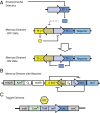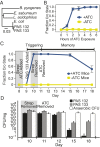Programmable bacteria detect and record an environmental signal in the mammalian gut
- PMID: 24639514
- PMCID: PMC3977281
- DOI: 10.1073/pnas.1321321111
Programmable bacteria detect and record an environmental signal in the mammalian gut
Abstract
The mammalian gut is a dynamic community of symbiotic microbes that interact with the host to impact health, disease, and metabolism. We constructed engineered bacteria that survive in the mammalian gut and sense, remember, and report on their experiences. Based on previous genetic memory systems, we constructed a two-part system with a "trigger element" in which the lambda Cro gene is transcribed from a tetracycline-inducible promoter, and a "memory element" derived from the cI/Cro region of phage lambda. The memory element has an extremely stable cI state and a Cro state that is stable for many cell divisions. When Escherichia coli bearing the memory system are administered to mice treated with anhydrotetracycline, the recovered bacteria all have switched to the Cro state, whereas those administered to untreated mice remain in the cI state. The trigger and memory elements were transferred from E. coli K12 to a newly isolated murine E. coli strain; the stability and switching properties of the memory element were essentially identical in vitro and during passage through mice, but the engineered murine E. coli was more stably established in the mouse gut. This work lays a foundation for the use of synthetic genetic circuits as monitoring systems in complex, ill-defined environments, and may lead to the development of living diagnostics and therapeutics.
Keywords: genetic switch; synthetic biology.
Conflict of interest statement
The authors declare no conflict of interest.
Figures




Comment in
-
Synthetic biology: E. coli reporter gets the inside scoop.Nat Rev Microbiol. 2014 May;12(5):314. doi: 10.1038/nrmicro3256. Epub 2014 Apr 1. Nat Rev Microbiol. 2014. PMID: 24686415 No abstract available.
-
Microbial genetics: Bacterial sensors report on the gut.Nat Rev Genet. 2014 May;15(5):290. doi: 10.1038/nrg3721. Epub 2014 Apr 2. Nat Rev Genet. 2014. PMID: 24690882 No abstract available.
-
Memoirs of a gut bacterium.Nat Methods. 2014 May;11(5):474. doi: 10.1038/nmeth.2953. Nat Methods. 2014. PMID: 24820364 No abstract available.
References
Publication types
MeSH terms
Substances
Grants and funding
LinkOut - more resources
Full Text Sources
Other Literature Sources

